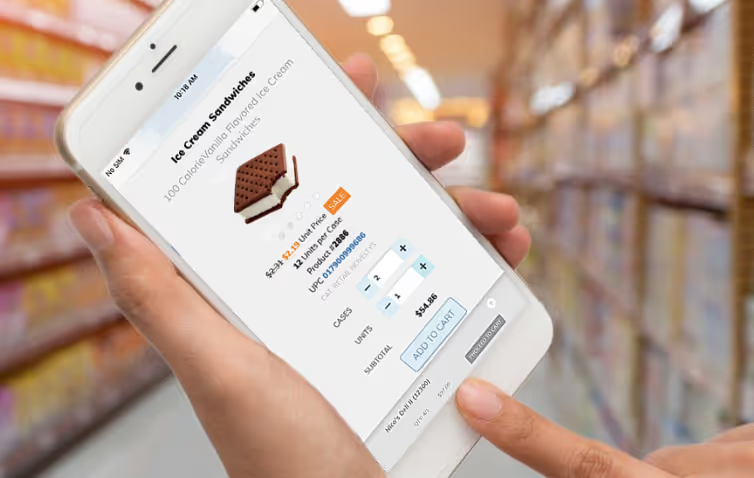Recent News
How Direct Store Delivery Mobile Software is Transforming the DSD Industry
Introduction
In today’s direct store delivery industry, speed, accuracy, and cost efficiency have transitioned from goals into necessities. However, meeting these demands can feel overwhelming for many DSD distributors. Thanks to the rise of mobile technology, DSD operations are becoming more streamlined, and they can now adapt more quickly to increasing demands and changes in their market.
In this article, we’ll explore the growth of mobile technology in DSD, its key benefits, and the must-have features for modern distributors.
The Rise of Mobile Technology in DSD

Traditional DSD relied heavily on manual, paper-based processes, often leading to inefficiencies, errors, and delays. Mobile technology reshaped how distributors operate, making these outdated methods obsolete.
Today, smartphones and tablets, combined with specialized DSD applications, have become essential tools for drivers and sales representatives. These devices provide several capabilities, including real-time data access, improved route management, higher transaction processing, and seamless integration with backend systems.
Mobile technology’s role in DSD continues to grow, driven by the need for greater efficiency and real-time responsiveness. A 2023 report by Allied Market Research projects the global mobile logistics market to reach $23.6 billion by 2030, with a compound annual growth rate (CAGR) of 9.7%. A Peerless Research Group survey also found that 73% of distribution companies have implemented or plan to implement mobile solutions, with many reporting a 15% reduction in delivery times and a 20% improvement in inventory accuracy. These numbers highlight mobile technology as a critical component in modern DSD strategies.
Key Benefits and Features of Mobile DSD
There are several key benefits and features that make mobile functionality a must-have in today’s DSD. Here are the most important ones:
- Real-Time Data Access and Order Management: Mobile devices provide real-time access to inventory levels, sales data, and customer orders. With real-time order tracking, sales reps and drivers can handle last-minute changes, quickly process payments, and directly adjust orders from their devices.
- Seamless Communication: Instant communication between drivers, warehouse staff, and management keeps everyone aligned. Additionally, mobile apps with offline capabilities allow operations to continue uninterrupted in areas with poor connectivity. By saving data locally and transmitting it once a connection has been restored, sales and orders are always kept up-to-date.
- GPS Tracking and Navigation: With mobile GPS capabilities, drivers can follow the most efficient routes to reduce fuel costs and delivery times. Additionally, integrating with Google and Apple Maps provides real-time adjustments based on traffic conditions, reducing delivery times and errors.
- Enhanced Customer Service: With mobile technology, distributors can provide real-time updates to customers and improve response times. Distributors can also access warehouse inventory to manage stock levels and efficiently meet customer demands.
- Mobile Invoicing and 100% Data Accuracy: The ability to generate accurate invoices from mobile devices speeds up the billing process. Mobile tools ensure delivery records are precise, even with last-minute changes. Invoices can be printed via thermal printers or emailed to customers, and they can be updated in real time to reflect accurate quantities, reducing disputes.
- Electronic Proof of Delivery (ePOD): ePOD allows drivers to capture signatures, take delivery photos, and store time-stamped records. This information is synced with backend systems, reducing the chance of disputes and providing instant proof of delivery.
- Inventory Management: Mobile devices allow for real-time stock tracking as deliveries are made. Distributors can manage truck inventory and place replenishment orders on the go. Access to live warehouse inventory also helps to avoid stockouts and overstock issues.
- Multi-Vending: This feature allows distributors to invoice on behalf of multiple vendors, enabling them to deliver their own products alongside vendor products. Vendor names appear on the invoice, and the system automatically uploads the data via Electronic Data Interchange (EDI), simplifying coordination and ensuring accurate billing.
- Asset Tracking: Mobile devices can scan and audit equipment, such as freezers, placed at stores. This ensures assets are functioning properly and up to standard.
- Additional Features from IntegraSys: IntegraSys offers Direct Exchange (DEX) to automate delivery data transfers between mobile devices and backend systems. As a result, administrative work is reduced, and invoicing accuracy is increased. Tools like Bluetooth-enabled DEX connections further streamline the delivery process by integrating with retailer systems.
Important Considerations with Mobile DSD
While mobile functionality offers many benefits for DSD operations, there are some important challenges to consider to ensure long-term success:
- Integration with Existing Systems: Integrating mobile technology with existing DSD software and legacy systems can be complex. Fortunately, solutions like those offered by IntegraSys are designed to seamlessly integrate with or even replace ERP systems, minimizing disruptions and streamlining data flow.
- Training and User Adoption: Introducing new technology requires comprehensive training to maximize a team’s potential. Investing in a comprehensive DSD training program helps overcome resistance to change, increase user adoption, and boost overall performance. With the right support, teams can quickly become proficient with new mobile tools.
- Security and Data Protection: Since mobile technology collects and transmits sensitive data, securing these communication channels is critical. Implementing encryption protocols, secure access points, and other protective measures helps mitigate security risks and safeguard valuable company information.
- Cost Considerations: While the upfront costs of hardware, software, and training may seem high, the long-term return on investment is clear. Mobile functionality improves efficiency, reduces delivery times, and enhances customer satisfaction, leading to lower operational costs and increased profitability over time.
Conclusion
Mobile functionality is no longer a luxury for today’s Direct Store Delivery operations—it’s a necessity. By streamlining communication, optimizing delivery routes, and ensuring real-time data accuracy, mobile technology is helping DSD distributors stay competitive in an increasingly fast-paced market.
Ready to see how mobile functionality can transform your DSD operations? Schedule a demo with IntegraSys and discover how our comprehensive mobile solutions can help your business reach new levels of efficiency and profitability.


.png)


.avif)